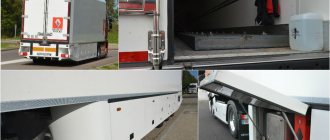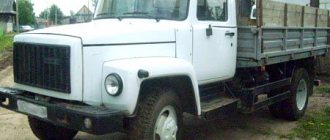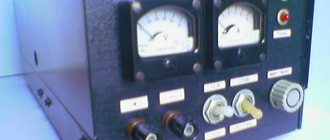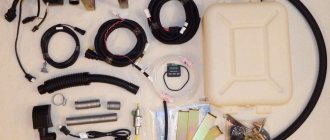“It’s like a vacuum cleaner with an iPhone built in.” Opinion of the driver of a diesel GAZ-3309
This GAZ-3309 is our “workhorse”. We use it to transport live fish from the Brest region to different cities of Belarus. We also trade in Minsk.
We bought this diesel GAZ-3309 in 2009. The diesel engine promised savings on fuel costs, so we settled on this version rather than the gasoline version. It consumes an average of 15.2 liters per “hundred”. In principle, acceptable.
A Minsk diesel engine is installed here - MMZ D-245.7 E3. This is a 4-stroke turbocharged engine. The arrangement of the cylinders is four in a row. Its working volume is 4.75 liters. Nameplate power - 119 hp. In principle, there were no problems with the motor itself. “Tractor” diesel is simple and reliable, but its fuel equipment...
There is an electronic control unit and Bosch injectors here. Branded equipment. He belongs on some fashionable Mercedes, but not on the GAZon. If something breaks, it's a big deal. The electronics block everything, it’s impossible to fix it yourself, you only have to turn to branded services.
And this is where the unpleasant “surprises” begin. Do you know how much it cost us to repair and flush the injectors? Thirteen million non-denominated rubles! Some fantastic figure for a seemingly simple machine. No, Bosch is clearly superfluous here. We need something simpler and cheaper.
The second “scourge” of this car is rust. We decided for ourselves that the cabins for these cars are made of “pioneer metal.” The pioneers will hand over the scrap metal, it will be melted down quickly and the result will be a LAWN cabin. The holes are huge and right through... Behind the cabin they haven't had time to patch it yet.
Let's look under the wing - there is no living place to be found. Everything started to rust - the car was not a year old.
You have to constantly touch up. Already tired. And some problem areas cannot be properly welded. Here they “nailed” a piece of tin to somehow cover up the corrosion.
The other wing is also all “swollen”. I don’t even remember how many times I repainted it. But a lot.
Another problem area for this particular car is the steering rack. It fails and that's it. It's been replaced five times already. We install a new one every year. The last repair, in my opinion, cost around 4,000,000 old rubles.
The frame and fuel tank are also problem areas of these machines. Colleagues are rusting. But specifically my car was lucky. Compared to the others there is almost no rust. Apparently, the pioneers who handed over the metal were diligent.
In terms of cabin comfort... “GAZon”, it is “GAZon”. No one expected any special miracles from him. I'm used to it. And I can safely say that it is warm in winter. The heating works well.
Don't look at the mileage numbers on the odometer. We've already changed it four times. For some reason this device keeps breaking down. Our average daily mileage is about 300 km, but sometimes it’s 800 km when we deliver goods to different cities. In total, the car ran about 300,000 km.
There was no standard radio here, but there was a place for it to be “embedded” into the panel. I cut out a rectangular hole and played “music” for myself. You won’t see this in many “LAWN” stores, but now I have it.
In general, this “GAZon” is a classic “workhorse” with simple units, but for some reason with “space” fuel electronics. It's like a "vacuum cleaner with a built-in iPhone." Expensive, complex German electronics are clearly too much. Now, as far as I've heard, they don't put it on anymore. For now, we still have to suffer a little. Ahead is the ritual of touching up the paint and replacing the cracked windshield.
Listened and recorded by Igor KHOLOSTETSKY Photo by ABW.BY
Partner of the section - GRUZON.BY. Do you need to transport something and need a truck? The service allows you to find, for example, a truck in a few clicks or place a request for cargo transportation, after which the carriers will offer you their conditions. All that remains is to choose a carrier and track the delivery of your cargo online on the map. There are already 460 cars registered in the system. And if you are a carrier and want to receive orders, this is the place for you.
Once, with my payday, I bought a “lawn”...
Choice. Normal owners sell cars when they cease to be a tool for making money and begin to require investment from their owners. The likelihood that a private owner, who has already tasted freedom, will decide to work for the state again and sell a fully functional car at a cheap price is extremely small, so the low price should alert the future buyer. Another thing is enterprises, not necessarily even state-owned, where road transportation is not the main activity. For them, another scenario is quite possible, when while the car is driving, everything is fine, but as soon as it needs to be repaired because of some little thing, the driver starts drinking and quits, and the neighbors in the stall begin to slowly dismantle the car. At some stage, the administration is already happy to get rid of the equipment by cutting it into scrap metal, and then there is a buyer... It’s even better to take the car from your place of work, because its entire biography is visible. But most purchases are made through advertisements. That’s how I chose a toy for myself. Machines operated by a private owner have much fewer problems with documents than equipment operated by state-owned enterprises. Still, entrepreneurs treat documentation more carefully. The only, not entirely pleasant, circumstance is that many private owners own cars by proxy. When buying a car, you want to be the owner, and not the confidant of a stranger. It's another matter whether the car depot is large or not. There are often situations when a driver loses documents, and would-be managers, instead of restoring them, replace the original chassis and engine numbers with the numbers of a long-rotten car. There are times when they assemble one from several machines and forget to document their creativity. There are fake documents even for... trolleybuses! As for the technical side of the matter, I was surprised by the huge number of riders who have ruined their equipment and are trying to get rid of it without even understanding the reasons. The most illustrative case is worth citing. I dial the phone number indicated in the ad and hear a story about how the owner of a GAZ-3307 he accidentally got was driving along the Moscow Ring Road, and I quote further: “My red light came on, but I drove on, then they told me that I needed to change the upper unit ( !) (obviously, the head, author's note). They asked for four thousand, so I’m selling the car.” In conclusion, this figure said that the car is not his at all, but he has 700 vouchers and experienced lawyers who will help if anything happens. In his opinion, the deal should be carried out according to the principle “you give me the money, I’ll give you the keys.” In another case, when I arrived to look at a car “in good condition,” I discovered a completely rotten cabin floor, a tow hook torn out of the frame, and side windows of the cabin made of plexiglass and cardboard. The battery box and the battery were missing; the entire property stood on completely flat tires. The owner assured that at least tomorrow he would deregister the car, and when asked where the battery was and how he was going to pump up the most likely squashed tires, he smiled embarrassedly and showed a hand pump. Although there are also opposite cases. At the time when I was looking for a flatbed car, a driver I knew was selling a GAZ-3307 van in really good condition for only 700 USD, but I didn’t need the van. In the end, my search ended at a company that installed shell garages. In the yard there was an almost rotten “lawn” with a “military” body, in which stood a frame for transporting “shells”. Having prepared to listen to another entertaining story, I was quite surprised that this time all the documents were in order. They immediately rushed to start the car. Everything seems to work, the engine does not knock, although the oil pressure is not enough: two atmospheres on a cold engine and one on a warm engine, but what do we want from a 10-year-old car? The engine, of course, was overhauled: rings and bearings were replaced. Since all the other sellers turned out to be science fiction writers and clowns, and my vacation was already coming to an end, then, in general, there was no choice left. The only questionable point was driving a car through Moscow traffic jams without a starter and a handbrake to a new place of residence, but after the selling party promised to provide the ace who worked on it for this task, he disappeared. The parties agreed that the amount of 1000 conventional units most fully reflects the technical condition of the car, and after receiving a deposit of 100 conventional units, the process of deregistration began. My carefree life is over. Hello school!
Eternal repair. Here we are standing with the “lawn”, taking a position to start the engine without a starter, at the top of a small hill and waiting for the ace driver. The former owners left, receiving 800 USD. (they had to knock off a hundred for the second gear refusing to engage), giving us a tent, two spare tires, a carburetor and some garbage. Gentlemen who buy used trucks! Don’t make a fuss about the garbage that will definitely be thrown into your truck. Firstly, this is a mandatory element of pre-sale preparation, and secondly, this is your first cargo! Ace has arrived, and we set off. Not even three minutes pass before a car without license plates is stopped at the exit to the Moscow Ring Road. It happened on Troekurovsky Proezd, where the post is located on a pass between a slight descent and ascent. No matter how you park the car, it will still start to roll without the handbrake. It is also impossible to turn off the engine and put the car into gear because the starter is not working. It's good that we went together! We take turns communicating with the traffic cop and pressing the brake. Traffic cops are politeness itself! They wish you a good journey and let you go.
While driving along the Moscow Ring Road, I notice that even on the smallest climbs I often have to switch to third gear - and this is with an empty car. The next day I began to examine the gearbox, hoping to find where the second gear had gone. Alas, it disappeared forever, as the gears (or clutch?) were completely eaten. This is not surprising, because the first two gears on the GAZ-3307 are not synchronized, and when the “green” light turns on, not everyone (and me too) has the patience to wait 2-3 seconds until the shafts in the box stop. I decided to change the assembled box, luckily I found an almost new one for three thousand. A new one in the store costs from 6 thousand. It's good that it's rubles. This procedure is one of the most unpleasant on any car, worse than disassembling the wheels. But thanks to two assistants, it went quite quickly, although both of them could have been replaced by a hoist if there had been a hatch in the roof of the cab, like many ZILs. At the same time, a “handbrake” appeared. Since I didn’t want to continue moving around the yard with the help of a forklift, the starter was next in line for repairs. During disassembly, it turned out that the solenoid relay had completely burned out, and the busbar going from the relay to the electric motor itself was welded to the body. The solenoid relay cost 230 rubles (probably because the starter is called ST-230), the tire was taken from a waste starter, the product was assembled and works to this day.
The engine did not want to start for a long time, but, in the end, we left the pit. I spent three lunch breaks throwing garbage out of the truck and removing the awning. At the same time, I replaced the “mass” switch that was accidentally found in the trash. Another useful thing in the back was a lock with a key, which took its place on the gas tank cap. It's time to sort out the ignition. Previously, I dealt with diesel engines, the smallest of which was the YaMZ-238, and the only gasoline engine in my life was a two-cylinder starter from a tractor. But there was a magneto there. By the way, a magneto is a very simple and reliable device; it produces a spark without a source of electricity. And here is some strange bunch of wires. It seemed so at first glance. But after a few minutes I could already tell that my car had a so-called “simple” ignition circuit, neither contact-transistor nor contactless. Looking ahead a little, I will say that, in my opinion, this is the best option. After all, the increase in spark power in all sophisticated systems is not very large, the main emphasis in the operating instructions is on extending the service life of the high-voltage contacts of the breaker-distributor, only the distributor cover costs 40 rubles, and a set of wires with a resistance of 2000 Ohm/m is no less than five hundred. So what happened to the ignition? But it went astray due to the fact that the distributor was not screwed into place with a bracket, but was tied with electrical tape. As a result, he swayed left and right by about 20 degrees. Well, what kind of car, other than a Soviet one, will start in such conditions? At first, for a long time it was not possible to set the ignition according to the factory instructions due to the fact that the TDC mark was incorrectly set on the pulley. The position of the top dead center was indicated by a barely noticeable notch. I got used to setting the ignition correctly using the starter. With the engine stopped, I turn the distributor a few degrees in the advance direction, after which I make several turns with the starter. If it becomes difficult for him to crank the engine, which is “reversing”, then he needs to step back a little. Of course, you can set the ignition with the engine running, catching the distributor position at which the idle speed is highest, but with a shaking engine it is not entirely convenient to record your achievements. By the way, if you accidentally get an electric shock at this moment from a high-voltage wire or through a lid, there is a good chance of ending up in the fan.
After installing the ignition, I had to tinker with the carburetor, since the car only worked on choke. Now this malfunction would not raise any questions in my mind: the cause could be either clogged jets or a low fuel level in the float chamber. This can also happen if the fuel filter is clogged. Since the fine fuel filter is not original, but a Zhiguli one, the first reason is practically excluded. It is a pity that modern carburetors do not have a window through which you can control the fuel level. The factory recommends doing this using a hose and a glass tube, but this is not entirely convenient on the road. The floats in the chamber can be iron or plastic. Iron ones most often drown after drinking too much gasoline; plastic ones have another problem - the tongue that presses on the locking needle is quite flimsy and can bend. In both cases we get an over-enriched mixture. The same result will occur if the needle jams, cutting off the fuel supply. In 90% of cases, a stuck needle can be sorted out by simply knocking on the carburetor. Of course, this will not eliminate the cause, but it will return it to working capacity for a while. A sunken metal float is best replaced.
It is best to start adjusting with the leanest mixture and gradually, bending the tongue, first achieve stable idle speed without suction, and then acceptable acceleration. It is important to stop in time and not make the mixture too rich. But all this knowledge comes with time, and when I first encountered problems with the carburetor, I disassembled and reassembled it many times and once dropped one of the mounting nuts directly into the spider. Not really trusting the magnetic screwdriver, I removed the spider, took out the nut, bought new gaskets for it, lubricated it with grease as required, and put the spider in place. The next day (and it was winter), as usual, before starting, I began to turn the crankshaft by hand and discovered that it was turning much more difficult than usual. My thoughts about the nature of this phenomenon were interrupted by the sound of a burst distributor drive. It turned out that water got into the engine sump through the spider gasket, and as a result the oil pump jammed. The protection against oil starvation on the 511 engine is radical. No electronics for you. The oil pump and distributor are driven by one thin hexagon. If something happens to the pump, the hexagon immediately bursts, the distributor stops and the car does not move further without oil.
If your car is filled with water, there is most likely a coolant leak somewhere. Be careful when purchasing. The problems with the engine ended after purchasing a new K-135 carburetor for 1,350 rubles (interesting pricing policy: how the part is designated, that’s how much it costs.) When buying a carburetor, you need to tell the seller the make of the car, because there are such carburetors for ZILs too. The car immediately drove as it should. All that remains is to replace the front wheels with the free assembled wheels of normal size. Now the pattern and dimensions of all the wheels of the car have become the same. You could go to the traffic police.
What is wrong with the lawn? Although I drove quite a bit - in a year and three months a little less than one and a half thousand km - I was very lucky with the repairs, so I will be brief. I spent money on purchasing a new carburetor for 1350 rubles and a new fuel tank (the old one was rotten in the front part and began to leak) for 2520 rubles. A fuel intake had to be used on the new tank. During the first 50 kilometers after replacing the tank, I changed three fine filters. By the way, as I said, they are not “native” to me, but transparent plastic ones. From the first days of buying the car, this system seemed to me a fire hazard, because the hoses do not run so far from the manifold and fan. I bought a “original” filter in the form of a “glass”, but never installed it. Fuel is supplied to it through rubber hoses, but the cleaning quality is low, since instead of a paper element it contains a metal mesh. Another thing is ZIL - where gasoline flows through copper pipes. When installing the tank, I overdid it a little, screwing the tube into the fuel filter. As a result, the housing cracked and leaked. I discovered this when I filled the tank full and the gasoline level became higher than the filter. He managed to get out of the situation and get there by removing the spilled fuel from the filter housing and frame and starting the engine. After all, a vacuum is created in the fuel lines to the pump, and gasoline leakage is sharply reduced. I dealt with a minor leak using sealant. The engine was not turned off until the sealant hardened. So I was able to get there, but the sediment filter will have to be changed: when parked for a long time with a full tank, it still “sweats”. This is extremely undesirable, given that there is a muffler nearby. And, finishing the topic with the power system, I would like to draw attention to the need for a tight fit of the lid to the filling neck. In hot weather, up to one liter of gasoline per day can evaporate through this seemingly insignificant leak.
valves. The only problem so far is the frequent unscrewing of screws to adjust the gaps. You adjust the valves as needed, drive for a month or two, and from under the valve cover you begin to hear, first a slight grinding sound, and then knocking sounds. If you do nothing, some cylinder will refuse to work. The engine will stop idling. You can determine a non-functioning cylinder by a “wet” spark plug and then adjust the valves only on the side where they knock. On any four-stroke eight-cylinder technology, this can be done in two revolutions of the crankshaft. First, we install one “dead point” on the pulley and adjust all closed valves, then turn the engine one revolution and adjust the remaining ones. The whole procedure takes about half an hour, the only problem is not to overtighten the valve covers during installation. They are very easily deformed. In this case, the rubber gaskets no longer adhere to the heads and oil begins to flow into the resulting cracks.
Cooling system. The biggest nuisance here was a barely noticeable crack in the block near the oil pump. Apparently, one day the driver forgot to drain the water from the left faucet of the unit. The crack was repaired by cold welding and it no longer bothers me. One day the pipe leading from the “spider” to the radiator leaked. The malfunction was noticed in time. The hose has been replaced. The previous owners smashed the radiator against the bus and installed a “fifty-first” in its place. But even with it, the car does not overheat.
Lubrication system. There is only one problem, but a big one: the oil filter does not want to unscrew. The instruction manual mockingly recommends unscrewing it by hand, but forgets to mention that this requires 150 years of arm wrestling. Then it might work out. I tried to unscrew it first with my hands, then with an open-end and chain wrench, then with a No. 5 gas wrench. Under the influence of such a tool, the filter housing began to curl into a spiral, and aluminum does not tolerate such abuse. I had to approach the problem from the other side. I removed the filter cap from the decommissioned “lawn” and planned to replace the entire “spider” over the next weekend. By the next weekend, the “spider” I had planned for installation had disappeared from the decommissioned car. I went to the store, they were glad that a new “Spider” costs 2,500 rubles and besides, they come in different varieties. The differences lie in the outline of the right front part. In short, I didn’t do anything. I figured that the old filter would last for another 2000 km, which is a whole year for me. Besides, I didn’t want to immobilize the car for a long time. After all, first you will have to break the cap to clear your conscience, then try to unscrew the crease, and only after that go shopping and look for a “spider” of the desired shape. As soon as the bypass valve whistles, I’ll go to some service. The pressure when starting the engine in winter is 2.5, and in summer 2 atmospheres, when driving at a speed of 60 km/h about one. In the July heat, when stuck in traffic jams, it dropped to almost zero, so during the hot period it was necessary to replace the M8B oil with diesel M14B2. Better the wrong lubrication than no lubrication at all. Of course, the engine will knock someday, but this will happen in 10–15 thousand. I am ready for this mentally and financially at any time. Repairing my engine in different places is estimated from 15 to 23 thousand rubles (a month without nightclubs).
Transmission. I replaced the gearbox with the second speed that refused to engage after buying the car, and at the same time I changed the clutch disc, although it was nothing old. I haven't changed the release valve, but the old one still works fine. In addition, it is unknown how much lubricant will be in the new one. The clutch constantly refuses to disengage normally. This happens for several reasons. Firstly, air may get into the clutch hydraulic system, and secondly, the lower cylinder itself or the adjusting nuts on its rod may unscrew. Thirdly, the hole in the pedal may become loose or the connection between the pedal and the hydraulic cylinder rod may come loose. Fourthly, the rod on the pedal itself is also adjustable. And finally, you need to monitor the position of the paws in the press set. They must be in a position in which the release bearing travel is sufficient to completely disengage the clutch, and, on the other hand, when the pedal is released, the release bearing does not rotate. The release bearing will always rotate if there is no return spring on the lower cylinder, and also if you are in the habit of constantly keeping your foot on the clutch. I had such a habit, but when I saw what it led to, I began to control myself. The assembly where the cylinder rod is attached to the pedal has fallen apart. When disassembling the unit, it turned out that the hole in the pedal had become oval. I hammered a bronze bushing into the pedal and the rod ear, and now there is no play. When trying to move off, the clutch cylinder rod burst. This happened less than a kilometer from the parking lot. Therefore, I got there without any problems, turning on first and moving off on the starter. You can also turn the third one on and off without a clutch, but this requires skill. It is not very convenient to fill the gearbox with oil and it is completely impossible to control its level. To fill the oil, you need to remove the lever, and there is no dipstick provided at all. By the way, the studs that attach the gearbox to the engine may be loosened or torn off. This is also one of the reasons for the clutch not disengaging. The cardan shaft passes through the suspension bearing, the holes for its fastenings in the frame are drilled so that the cardan shaft stands a little crooked. Don't try to fix it: that's the way it should be. There is nothing to say about the rear axle. It works and that's it. It doesn’t even make noise, and when I tried to add oil, no more than half a liter fit in, with a total crankcase capacity of fifteen liters. The rear wheels have one problem: they do not turn away. When the car is running in the city, punctures are relatively rare, but if the rear wheels get punctured, it is almost impossible to turn them off. Neither the nuts, nor especially the fittings, want to come off. It is better to unscrew them in advance by heating them with an autogen. Some drivers grind the liners so that both rear wheels are secured only with nuts, but I think it was not for nothing that the designers muddied all this up and they still had some reasons to make the liners the way they are.
When purchasing the brakes I was pleased with their smooth and efficient operation. But over time, their efficiency began to imperceptibly decrease, and a red light began to light up on the instrument panel at low engine speeds. For a long time I did not bother to look in the book what it was, believing that the light indicated insufficient oil pressure. Everything became clear when I was cut off quite badly and had to brake sharply. No brakes! The pedal effort is enormous. The next morning, trembling with fear and starting to slow down in front of traffic lights 150-200 meters away, I hobbled to work. When trying to slow down on a dusty road, it turned out that the front wheels did not skid at all, and the rear wheels did not start braking at the same time. The relative simultaneity of the start of braking of the rear wheels was achieved by installing the pads. When figuring out the reasons why the front axle did not brake, we first discovered a torn hose going to the vacuum booster. I changed it but it didn't get any better. When dismantling the wheels, it turned out that on each wheel one of the pads had become sour and did not move. The problem has been resolved. Braking is still sluggish. I crawled under the car to inspect the vacuum pipe connections again and accidentally poked the vacuum booster reservoir with a screwdriver. He pierced easily. Next, I gave him a knife fight, just like in the police reports, and there was no area on him that could withstand a screwdriver. The new tank cost a little over 300 rubles. The braking efficiency immediately increased, the effort on the pedals became acceptable, but still the front wheels did not want to skid. I accelerated to 40 and braked sharply to check what the stopping distance was now. Instead of the 18 meters required by GOST, I kept it to 12. The result was considered satisfactory. To make the front wheels skid, you need to sharpen the front drums: over the years of working with only one pad, each of them has worn out in a special way.
As for electrical equipment, most malfunctions arise due to the lack of “ground” among consumers. These could be rear lights, brake lights, or a horn. One day the charging relay burned out (it is separate from the generator). What's new is a smoking ignition switch (a new one cost 120 rubles) and a sound signal not working due to lack of power on the steering column switch. I had to throw the “snot” right off the safety switch. In the ignition system, the contacts in the distributor cover often burn out due to a poor connection, and the engine begins to stall. Distributor caps, runners and spark plugs are consumables. I also carry a spare ignition coil and capacitor with me. Ignition wires are a lottery. It may also be that after replacing the wires the car refuses to start. By the way, owners of equipment with a “simple” ignition do not need to spend money on expensive wires at five hundred rubles per set. This is for electronics engineers. A set of wires for a regular ignition costs from 80 to 100 rubles. “Lawn” in action. After waiting until the shafts stop, we engage second gear. In principle, the second one is always enough for starting, with the exception of cases of traveling with a heavy load and starting on an incline. The easiest way to change gears is to double-depress the clutch, and downwards also with a shift in the throttle. After a little practice, transmissions, including unsynchronized first and second ones, will be switched on literally with one finger, up and down. So there are no complaints about the box. Hydraulic brakes, unlike pneumatic brakes on the ZIL-130, provide smooth and predictable deceleration. Although, during emergency braking, pneumatics are more powerful. Yes, and you will have to take off on an incline, when there is a car behind you, using the handbrake or using the manual gas. The steering only benefits from the absence of a power amplifier. There is no looseness and lack of information characteristic of ZILs. Even at 80 km/h you can (but do not need to) let go of the steering wheel on a good road. The car will not start moving across the road very soon. The only difficult case is leaving a rut and driving onto the side of the road at an acute angle. That's when you have to hold the steering wheel very tightly, otherwise it will break out of your hands. Turning the steering wheel, even if not equipped with a power steering, does not cause any difficulties. The only complaint is that the turning radius is too large. Performing this maneuver in one go requires a four-lane road with wide outer lanes. If you perform the exercise from the right side of the road, having previously turned the steering wheel to the “left side” position, then the maneuver will be completed exactly at the opposite curb. In the city, with an empty car, cranking the engine in second and third gears, it is quite possible to stay in the general flow of cars. Driving at high speeds is hampered by numerous potholes on the roads. Once in a pothole, the unloaded rear axle rises into the air for a split second and after landing, the car points its nose slightly to the side. Here it is important not to relax and correct the direction in time. If you drive over a completely harmless bump or patch on the asphalt at a speed of 70-80 km/h, the whole car can jump. Once after a jump I found myself half a meter to the left. Hello neighbors down the road! So it is better not to apply the principle “more gas - fewer potholes” for city streets. The most optimal speed for the city is 45-55 km/h. At the same time, fuel consumption is somewhere around 30 liters per “hundred”. On the highway, the most suitable speed can be considered 60-70 km/h. Fuel consumption is just under thirty liters. If you set the goal to save money, then you can completely meet 24 l/100 km at 50-60 km/h. When driving at high speeds, your appetite grows fantastically. I myself don’t drive under 90, but from the experience of operating “flyers” based on the GAZ-3307 at my previous job, I can say that it reached 40 l/100 km. But it's still a shame. A forty-ton diesel road train is moving along the adjacent lane at the same speed, consuming the same 40 liters, only diesel fuel.
In short, the GAZ-3307 is a good vehicle, less voracious and more convenient to drive than the “one hundred and thirtieth” and its modernization. As for the carrying capacity, in real conditions it is rarely fully used. And any car can break down. Buy it while it lasts: the plant will soon begin producing the Valdai, but it looks like a Gazelle and no one will respect you on the road.
And a little more about MAZs
In the article “operating experience of MAZs”, published in No. 4, 2004, the authors criticized the water pump drive installed on engines of the YaMZ-236 and 238 family. And here you go, “you wrote to us, measures have been taken.” The design of the pump drive has been changed. Now it has a regular tensioner, exactly as the authors recommended. In fact, the authors, of course, have nothing to do with it. The designers decided everything and implemented it without us. And, regarding the two leaking oil seals on the side of the box, I would like to say that one of them was replaced “just in case” when the driver, in search of a non-existent fault in the clutch, halved the power unit. He did not admit it in time, and was severely punished. Also, during the reporting period, a very instructive incident occurred with a naturally aspirated YaMZ-238 engine rebuilt in a garage. During assembly, a barely noticeable piece of scale got under the sealing ring of the sleeve. Since everything was mounted on solid oil, the malfunction was discovered only when the engine had been running for half an hour and had warmed up to operating temperature. So, even with such a simple motor, you need to be careful when repairing it, and vigilant when accepting it. Well, if anyone has anything to add, write, and, if possible, take photographs, or simply do not throw away failed components and assemblies. By the way, this applies to any car, not just MAZ. Share
Reviews of GAZ 3309 Rating: 1.8 out of 5 14 reviews found
30.11.2011
About a dozen cars were purchased for the company in 2011. I drove it myself for a week and then monitored breakdowns. Cheap. Repairable Compared to 3307 - much better. Armchairs from Gazelle, hydrak, thank God, it started working at idle. The brakes are light and not informative - pneumohydraulic. The clutch is a bit heavy, but I think it will get used to it. Gas is also not informative. Feedback is felt only on the clutch. The simple Gazonovsky steering wheel, the old soviet panel is readable and informative, but there is no need to talk about ergonomics. Without a load - a stool, it doesn’t buckle only thanks to the heavy attachment - a ref and a sandwich. Under a load of about 4 tons - like an iron. Irregularities cause vibrations and clattering of tires (road tires are a bit harsh). It is stable in corners at speeds up to 45, at a flat 60, but with a fragile load such issues do not arise. Without a load, 60-70 along the Ring Road junctions. There is a risk of toppling over in a turn; when the speed increases, the center of gravity is high. There is no reverse dynamics at the steering wheel or when cornering. You need to turn it back too. The tractor engine has plenty of traction. On overpasses with a load in 4th gear - no problem. Empty - it carries cars away from traffic lights) The maximum speed is limited. I couldn’t accelerate it above 95 (not downhill)))), although the same 90 goes uphill with a load. I make a disclaimer here. After purchase, all cars were subjected to additional tightening of nuts, clamps, screws and bolts by the company's mechanics even before leaving the territory of the company - the seller, and upon arrival at the park, they also changed the oils. I drove one of the cars from the place of purchase - I saw it. In the first months, marriages emerge. I saw a problem with the lack of pressure in the brakes (not the compressor), one of the cars stubbornly refused to hold XX. Otherwise, I haven’t heard any jambs in 3 months of daily work. It is distinguished by the company 25\100 in real life, in the cycle city - there - load - back - empty was invested in 23 (the engine was not turned off while waiting for unloading) empty - up to 20 load 22-27, depending on the driver’s economizing skills or his love of stomping the pedal. In terms of price and quality, I would recommend 3309 euro2 D.245 Although Euro 3, with proper care it is no worse. Cummins, made in China, has not yet suffered from quality and reliability. The machine is aimed, in principle, at one goal - to reduce delivery costs - this ensures the competitiveness of the company as a whole. Accordingly, with a good gasket between the steering wheel and the seat, the effect is achieved.
“I haven’t moved from my LAWN to the new MAZ.” GAZ-3307 driver's opinion
— This machine is used as an emergency repair kit for Minsk cable networks. It is engaged in delivering teams of repairmen to emergency calls and routine maintenance of electrical equipment. The body here is the Belarusian Lyubava, the chassis is the classic GAZ-3307.
The daily mileage averages 60-80 kilometers in the city and surrounding areas. We have been operating this machine since 2006, that is, this year marks its first anniversary - 10 years of operation.
I myself have been driving GAZons for 33 years. I caught the GAZ-51, but didn’t work on it. But the subsequent GAZ-52, GAZ-53 are the cars behind the wheel of which my work career began.
I try to take care of the car. I prepare for the annual technical inspection myself in our repair area. As a rule, two or three days is enough for me, since the car is “inspected.” Others may be under repair for two or three weeks. If there are any malfunctions in the car, I can tell by the sound. Still, three decades of “communication” with these trucks have established a kind of “internal connection” between us.
The engine here is petrol ZMZ-511.10. Scientifically speaking, 4-stroke carburetor with liquid cooling, displacement - 4.25 liters.
Our fuel consumption is specified in the standards. Summer and winter standards are different. Previously, the winter standard was considered to be 32.4 liters per hundred. It was very difficult to fit into it. Then a specially appointed organization conducted almost scientific research, and our winter standard was raised to 34.8. Summer was increased from 30 liters to 32.3 per 100 kilometers. These are real numbers, you can meet them, but you need to watch your driving style, use coasting, etc. We strictly monitor this.
Would I like a diesel? No. A gasoline engine is more reliable in cold weather.
As for corrosion, of course it is present. It is almost impossible to completely get rid of it. On the other hand, I saw much younger trucks of this model, where the fenders were already completely rotten.
We paint it ourselves in our own workshop. Naturally, the quality of the coating differs from the factory one; on the other hand, there is a significant saving. Transport is technological, my task is to maintain its acceptable appearance with minimal costs, and preferably without them at all. Let's be smart and get through it.
However, miracles do not happen. Another year passes, and rust makes itself felt again. By the next technical inspection it will not be there externally. We won’t eliminate it, but we will disguise it.
Suspension and ride comfort? The suspension is here - it couldn't be simpler. It hasn’t changed much since the days of the “fifty-first” LAWN. I don't know what needs to be done to make something break here. Nothing has changed in 10 years. Everything is “native”. Rides. This is a very simple machine in design, one might even say the simplest. There are no electronics at all, which is an advantage for me.
Dashboard and ergonomics? Everything here is definitely better than in the GAZ-53. The devices have a strict and laconic “military” style, and I don’t need anything more.
We recently renewed our vehicle fleet. New medium-tonnage MAZs have arrived. I had the opportunity to transfer from this LAWN to a new MAZ, but I didn’t want to. The LAWN is dearer and dearer to me. In fact, my whole life is connected with these trucks. Therefore, I would be happy to sit on the same lawn, only new. It’s a pity that GAZ no longer produces gasoline versions.
Editorial Help
The Gorky Automobile Plant really no longer produces gasoline versions, but diesel engines are still on the assembly line, and, despite the appearance of the GAZon Next model, no one is complaining about the lack of demand for the “old” car. Minsk diesel engines MMZ D-245.7 and Cummins are installed under the hood. These cars are designated GAZ-3308 and GAZ-3309. Now they are not mentioned even on the official website of the plant, but they are nevertheless present in the program and are offered for sale.
Listened and recorded by Igor KHOLOSTETSKY Photo by ABW.BY
Partner of the section - GRUZON.BY. Do you need to transport something and need a truck? The service allows you to find, for example, a truck in a few clicks or place a request for cargo transportation, after which the carriers will offer you their conditions. All that remains is to choose a carrier and track the delivery of your cargo online on the map. There are already 460 cars registered in the system. And if you are a carrier and want to receive orders, this is the place for you.










